Islamic Republic of Iran |
 |
| Name |
Three Colour Flag |
|---|
| Use |
National flag and ensign  |
|---|
| Proportion |
see below |
|---|
| Adopted |
29 July 1980 (1980-07-29) |
|---|
| Design |
A horizontal tricolor of green, white and red with the National Emblem in red centred on the white band and the Takbir written in the Kufic script in white, repeated 11 times along the bottom edge of the green band and 11 times along the top edge of the red band, for a total of 22 times on the fringe of the bands. |
|---|
The current flag of Iran (Persian: پرچم ایران, Parcham-e Irān) was adopted on 29 July 1980, and it is a reflection of the changes brought about by the Iranian Revolution. Its field is a tricolour comprising equal horizontal bands of green, white and red.
Flag description
Emblem
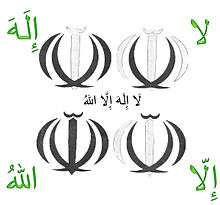
The
Tawhid is an emblem of Iran
.jpg)
Decorative with emblem of the Islamic Republic of Iran.
The parliament, per the 1980 constitution, changed the flag and seal of state insofar as the Lion and Sun were replaced by the red emblem in the centre of the flag. Designed by Hamid Nadimi, and officially approved by Parliament and the Leader Grand Ayatollah Khomeini on 9 May 1980, this Emblem is a highly stylized composite of various Islamic elements: a geometrically symmetric form of the word Allah ("God") and overlapping parts of the phrase lā ʾilāha ʾillā l-Lāh, (There is no God Except Allah), forming a monogram in the form of a tulip it consists of four crescents and a line. The four crescents read from right to left; the first crescent is the letter aleph, the second crescent is the first laam; the vertical line is the second laam, and the third and fourth crescents together form the heh. Above the central stroke is a tashdid (a diacritical mark indicating gemination) resembling "W". The tulip shape of the emblem as a whole memorializes those who have died for Iran and symbolizes the values of patriotism and self-sacrifice, building on a legend that red tulips grow from the shed blood of martyrs.
This emblem is somewhat similar to the Khanda but has no relation to Sikhism and its meaning to that religious community.
Kufic script
Written in white and repeated eleven times on the inner edges of each the green and the red band is the phrase Allahu Akbar (Allah is the greatest) in a stylized version of the kufic script. This symbolizes the calls of Allahu Akbar on the night of 22 Bahman (11 February 1979) when the national radio of Iran broadcast: "From Tehran, the voice of the Islamic Republic of Iran" and marked the unofficial beginning of the Islamic Republic (with the official day being 2 May). This writing renders the flag non-reversible.
Colours
Green
In the Iranian culture, it symbolizes growth, happiness, unity, nature, vitality, and the Persian Language. Historically, a green and white flag in a triangular form used to be the flag of the Persians (Pars).
White
The traditional colour of white stands for freedom, because white is blank and it is free to hold anything on it.
Red
It stands for martyrdom. In the Iranian culture, it symbolizes bravery, fire, life, love, warmth, and sophistication. Historically, a red and white flag in a triangular form used to be the flag of the Medes (Mada).
Since Cyrus the Great, a Persian, defeated his grandfather Astyages the High Judge (King) of the Medes and founded Iran by uniting the Persians and the Medes. The Iranian flag (which was later designed under Darius I the Great) symbolized this unity and victory (green above white and red) as the flag of the people of Iran.[1]
Construction
.svg.png)
Flag using compass-and-straightedge construction
Physical requirements for the Iranian flag, the exact shape of the emblem, and a compass-and-straightedge construction are described in the national Iranian standard ISIRI. The flag's aspect ratio is explicitly set at 4:7 in the standard; however, constructing the flag using the compass-and-straightedge construction results in an irrational aspect ratio of 1 : 75/28(7√5 − 15) or approximately 1:1.7477 (i.e. 4:6.9908).[2][3][4]
History
Flags, standards, and banners have always been important national and imperial symbols for Iranians, both in war and peace. Xenophon reports that Cyrus the Great's standard was a golden eagle with spread wings, mounted on a long shaft.
The best-known symbol of Iran in recent centuries has been the Lion and Sun motif, which is a graphic expression of the astrological configuration of the sun in the sign of Leo, although both celestial and animal figures have long and independent histories in Iranian heraldry. Late in the nineteenth century the Lion and Sun motif was combined with an earlier scimitar motif and superimposed on a tricolour of green, white, and red. With minor modifications, this remained the official flag until the revolution of 1979.
Achaemenid empire
The Old Persian word for "banner, standard" was derafš (Avestan drafša-, Middle Persian drafš, cognate with Sanskrit drapsá-).
Xenophon in Cyropaedia (7.1.4) describes the standard of Artaxerxes II at Cunaxa as "a golden eagle, with outspread wings, borne aloft on a long spear-shaft".[5] Since the flag being described is different from the flag made by Cyrus the Great, it may be a later version.
According to Herodotus (9.59), each Persian army division had its own standard, and "all officers had banners over their tents" (Xenophon, 8.5.13). One such banner, a square plaque in saltire, is depicted on a Greek vase, the so-called "Douris cup" held by the Louvre.[6] A similar design is known from an Urartian bronze disk from Altıntepe.[7]
Similar square plaques on poles are known from six of the audience scenes of the Throne Hall relief at Persepolis.[8]
The Alexander Mosaic of Pompeii, a Roman-era copy of a Hellenistic painting dated c. 320 BCE, also shows the royal Persian standard.,[9] depicted as a rectangular plaque, possibly originally in purple, with a dark red border with yellow dots. In the field, a golden bird is only partially preserved.
The "Persian bird" has variously been interpreted as a cock, an eagle or a falcon; the "royal falcon" of Persia (varəγna) represented farr or "glory", while the eagle was associated with the Achaemenid dynasty itself.[10]
A square tile representing a miniature (12 cm2) banner
was discovered at Persepolis in 1948.[11] The tile is made of Egyptian blue frit and likely represents Egyptian Horus, but in the Persian context suggests local association with the Avestan varəγna or the royal eagle of the Achaemenids.[12]
Sassanid empire
In Sassanid times the imperial flag was a leather rectangle covered with a thin layer of silk ornamented with jewels, with a four-pointed star at the centre, indicating the four corners of the world. This is the same star referred to as Akhtare Kaviani ("the Kaviani star") by Ferdowsi in the epic Shahnameh (Book of Kings). The flag was larger than the original Derafshe Kaviani apron and suspended from a lance, the point of which appeared above it. Attached to the lower edge were tassels of yellow, magenta, and scarlet, with large pendant jewels. The flag was destroyed by invading Muslim Arabs after their decisive defeat of the Sassanids.
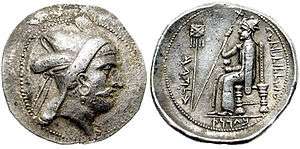
Derafsh Kaviani appearing in a coin of a local Persian dynasty that arose near
Persepolis during the
Seleucid reign.
[13] Islamic Iran
The Sassanid state collapsed on the emergence of an Islamic empire in the Middle East. Since Islam strictly prohibited figurative and expressive symbols as idol worship, all the traditional emblems used in Iranian flags were eliminated. Throughout this period there was no flag specific to Iran, although the use of Islamic banners was common.
Ghaznavid dynasty
The Turkic Ghaznavid dynasty were invested in promoting Iranian culture. They are known to have displayed a number of heraldic emblems that harked back to pre-Islamic Iran, including the Sun and Lion motif, as well as the Griffin motif.[14]
Their banners appear to have shown chequered motifs.[15]
Safavid dynasty
The Safavid Dynasty (1501–1736) used three green flags, each with a different emblem. Ismail I, the first Safavid king, designed a green flag with a golden full moon. In 1524 Tahmasp I replaced the moon with an emblem of a sheep and sun; this flag was used until 1576. It was then that Ismail II adopted the first Lion and Sun device, embroidered in gold, which was to remain in use until the end of the Safavid era. During this period the Lion and Sun stood for two pillars of the society: the state and religion. Although various alams and banners were employed by the Safavids (especially during the reign of the first two kings), by the time of Shah Abbas I the Lion and Sun symbol had become one of the most popular emblems of Iran.
The Safavid interpretation of this symbol is believed to have been based on a combination of historical legends like the Shahnameh, stories of prophets, and other Islamic sources. For the Safavids the king (shah) had two functions: he was both a ruler and a holy personage. This double role was considered the patrimony of the Iranian kings, derived from Jamshid, mythical founder of the ancient Persian kingdom, and Ali, the first Shi'a Imam. Jamshid was associated with the sun and Ali with the lion (from his epithet "Lion of God"). The correspondence may originally have been based on a learned interpretation of the Shahnameh references to "the Sun of Iran" and "the Moon of the Turanians". Since the crescent moon had been adopted as the dynastic (and ultimately national) emblem of the Ottoman sultans, who were the new sovereigns of Rum, the Safavids of Iran, needing to have a dynastic and national emblem of their own, chose the Lion and Sun motif. The sun had further important meanings for the Safavid world, where time was organized around a solar calendar, in contrast to the Arabo-Islamic lunar system. In the zodiac the sun is linked to Leo; for the Safavids the Lion and Sun symbol conveyed the double meaning of the royal and holy figure of the shah (Jamshid and Ali), the auspicious astrological configuration bringing the cosmic pair and the earthly—king and imam—together.
Regarding the Safavid understanding of the Lion and Sun motif, Shahbazi suggests that "the Safavids had reinterpreted the lion as symbolizing Imam ʿAlī and the sun as typifying the 'glory of religion', a substitute for the ancient farr-e dīn." They reintroduced the ancient concept of God-given glory (farr) to justify their rulership, attributing these qualities to Ali while tracing the king's genealogy through the Shia Fourth Imam's mother to the royal Sassanian house.
Afsharid dynasty
The Afsharid dynasty had two royal standards, one with red, white, and blue stripes and one with red, blue, white, and yellow stripes. Nader Shah's personal flag was a yellow pennant with a red border and a lion and sun emblem in the centre. All three of these flags were triangular in shape.[16][17]
Nader Shah consciously avoided the using the colour green, as green was associated with Shia Islam and the Safavid dynasty.[18]
Navy Admiral flag being a white ground with a red Persian Sword in the middle.[19]
.svg.png) |
| An Imperial Standard of the Afsharid dynasty |
|
.svg.png) |
| Another Imperial Standard of the Afsharid dynasty |
|
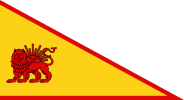 |
| Nader Shah's flag |
|
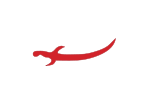 |
| Naval flag of Afsharid period |
|
Zand dynasty
The state flag of the Zand dynasty was a white triangular pennant with a green border and a gold lion and sun in the centre.[17] Another version included the same design but with green and red.
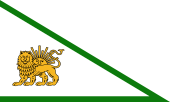 |
| Flag of the Zand Dynasty |
|
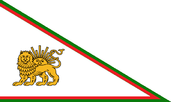 |
| Another Flag of the Zand Dynasty |
|
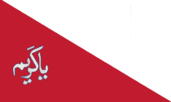 |
| The "Ya Karim" flag, which was a pun on Karim Khan Zand's name, and Al-Karim (the generous), which was one of the Islamic names of God |
|
Early Qajar dynasty

Flag of Iran during
Fath Ali Shah’s reign in the early 19th century, depicted by Drouville
Unlike their Zand and Afsharid predecessors, the Qajar rulers used rectangular flags. The flag of Mohammad Khan Qajar was red with a gold lion and sun inside of a pale yellow circle.[16]
Fat′h Ali Shah adopted a lion emblem on a plain red field as his war flag. The main emblem was a lion couchant in front of a sun, but a design featuring a lion passant holding a sword was also in use.[17] There was a green version of the flag for peace time and a white version for diplomatic purposes.[20]
During the reign of Mohammad Shah, the two different lion emblems were combined into a single flag which featured a lion passant holding a sword in front of a sun.[17][17][18]
Under Nasser al-Din Shah, the principal flag was white with a green border on three sides and a lion and emblem in the centre.[21][22] There was also a naval ensign which had a red and green border and a civil ensign which looked the same as the naval ensign but without the lion and sun in the middle.[21][23]
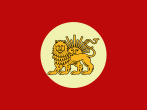 |
| Flag of Mohammad Khan |
|
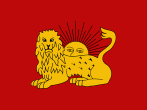 |
| War flag of Fat′h Ali Shah |
|
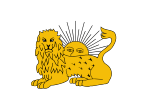 |
| Diplomatic flag of Fat′h Ali Shah |
|
.svg.png) |
| Peace flag of Fat′h Ali Shah (version with sword) |
|
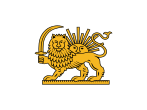 |
| Flag used during the reign of Mohammad Shah |
|
 |
| Tricolour flag designed by Amir Kabir |
|
 |
| State flag until 1906 |
|
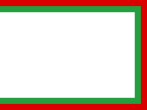 |
| Civil ensign until 1906 |
|
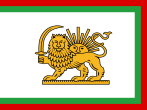 |
| Naval ensign until 1906 |
|
.svg.png) |
| Tricolour flag reported in 1886 |
|
Post-Constitutional Revolution
The first version of the modern Iranian tricolour was adopted in the wake of the Iranian Constitutional Revolution of 1906.[23] The Supplementary Fundamental Laws of 7 October 1907 described the flag as a tricolour of green, white, and red, with a lion and sun emblem in the middle.[24] A decree dated 4 September 1910 specified the exact details of the emblem, including the shape of the lion's tail ("like an italic S") and the position and the size of the lion, the sword, and the sun.[25]
During this period, the colours of the flag were very pale, with the red appearing closer to pink in practice. There were three variants of the flag in use. The state flag was a tricolour with the lion and sun emblem in the centre. The national flag and civil ensign was a plain tricolour with no emblem. The naval ensign and war flag was similar to the state flag, but the emblem was surrounded by a wreath and surmounted by a crown. All three flags had a 1:3 ratio.[23]
The flag was modified twice during the Pahlavi era. In 1933, the colours of the flag were darkened and the design of the emblem was changed. The sun's facial features were removed and the Kiani Crown on the naval ensign was replaced with the Pahlavi Crown.[26] In 1964, the ratio was changed from 1:3 to 4:7 and the emblem on the naval ensign was shrunk to fit entirely within the white stripe.[27]
Following the Iranian Revolution, the Interim Government of Iran removed the crown from the naval ensign. The old state and national flags remained unchanged until 29 July 1980, when the modern Iranian flag was adopted.[28]
.svg.png) |
| Naval ensign (1907–1933) |
|
.svg.png) |
| National flag (1907–1933) |
|
.svg.png) |
| State flag (1907–1933) |
|
.svg.png) |
| Naval ensign (1933–1964) |
|
.svg.png) |
| National flag (1933–1964) |
|
.svg.png) |
| State flag (1933–1964) |
|
.svg.png) |
| Naval ensign (1964–1979) |
|
.svg.png) |
| National flag (1964–1980) |
|
.svg.png) |
| State flag (1964–1980) |
|
.svg.png) |
| Naval ensign (1979–1980) |
|
The Lion and Sun symbol represented the "oppressive Westernizing monarchy" that had to be replaced, despite the emblem’s traditional Shi'a meanings and the lion's association with Ali, the first Imam of the Shi'a.[29] For that reason, the name of the Red Lion and Sun Society was changed to Red Crescent Society.
Currently, the Lion and Sun flag is used by Iranian communities in exile as a symbol of opposition to the Islamic Republic, similar to most Vietnamese expatriates' use of the South Vietnamese flag. Some political groups in Iran, including monarchists and the People's Mujahedin, continue to use it as well. In Los Angeles, California and other cities with large Iranian expatriate communities, the Lion and Sun, as a distinguishing marker, appears on Iranian flags and souvenirs to an extent that far surpasses its display during the years of monarchy in its homeland, where the plain tricolour was usually used.[31]
Similar flags
See also
References
Citations
- ↑ Koch, Heidemarie 1989: Persepolis. Theran Yasavoli
- ↑ ISIRI 1 (Persian), 1st revision. Retrieved 19 June 2012
- ↑ ISIRI 1 / IRANIAN ISLAMIC REPUBLIC FLAG, 1371 (Persian), 3rd edition, March 1993. Retrieved 19 June 2012.
- ↑ Construction of the Flag and the Coat of Arms of the Islamic Republic of Iran
- ↑ George Henry Preblem, The Symbols, Standards, Flags, and Banners of Ancient and Modern Nations, The Flag Research Center (1980).
- ↑ E. Pottier, Douris, London, 1909, p. 105 fig. 20, Plate XXV.b
- ↑ O. A. Taşyürek, "Darstellungen des urartischen Gottes Haldi," in: S. Şahin, E. Schwertheim, J. Wagner (eds.), Studien zur Religion und Kultur Kleinasiens. Festschrift für Friedrich Karl Dörner, Leiden, 1978, p. 942 fig. 7; pl. CCXVIII/4-5.
- ↑ E. F. Schmidt, Persepolis I, III, Chicago, 1953, 1970., p. 166, pls. 98, 99, 123.
- ↑ T. Hölscher, Griechische Historienbilder des 5. und 4. Jahrhunderts v. Chr., Würzburg, 1973, pp. 122-69, 270-88.
- ↑ Aelian, De Natura Animalium 12.21 has a legend of Achaemenes having been raised by an eagle. Ezra (18:13) has "Eagle of the East" in reference to Cyrus.
- ↑ Īrān-Bāstān Museum, Tehran, no. 2436; Sāmī, Persepolis, tr. R. Sharp, Shiraz, 1970, fig. facing p. 100; H. Luschey, "Ein königliches Emblem," AMI 5, 1972, pp. 257-60.
- ↑ A. Shapur Shahbazi, DERAFŠ, Encyclopedia Iranica (1994, 2011).
- ↑ Wiesehöfer, Josef. "FRATARAKA". Encyclopædia Iranica. Retrieved 22 July 2012.
- ↑ K. Farrokh, The Lion and Sun Motif of Iran: A brief Analysis (2009), citing S. Nafisi, Derafsh-e Iran va Shir o Khoshid [The Banner of Iran and the Lion and the Sun]. Tehran: Chap e Rangin (1949), pp. 45, 48-58; G.H. Yusofi, Farrokh e Sistani. Mashad, (1962), p. 422.
- ↑ based on the History of Rashid-al-Din Hamadani, see
Rice, D. T., & Gray, B., The Illustrations of the “World History” of Rashīd al-Dīn, Edinburgh (1967), plates 38, 44, 57, 60.
- 1 2 "Flags of the World: Persia (Iran) from XVI to XVIIIth century". Retrieved 11 November 2010.
- 1 2 3 4 5 "The Lion and Sun Motif of Iran: A brief Analysis". Retrieved 12 November 2010.
- 1 2 "Encyclopædia Iranica: FLAGS i. Of Persia". Retrieved 12 November 2010.
- ↑ Nādir Shāh's Campaigns in 'Omān, 1737-1744
By Laurence Lockhart, Bulletin of the School of Oriental Studies, University of London,Vol. 8, No. 1 (1935), pp. 157-171
- ↑ "Iranian Flag, A Brief History (English version)" (PDF). Retrieved 12 November 2010.
- 1 2 "Flags of the World: Persia (Iran) in the XIXth century". Retrieved 12 November 2010.
- ↑ Le Gras, M. A. (1858). Album des pavillons, guidons et flammes de toutes les puissances maritimes. Paris: Dépôt des Cartes et Plans de la Marine.
- 1 2 3 "Flags of the World: Iranian Empire (Qajar dynasty, 1905-1925)". Retrieved 10 November 2010.
- ↑
 Iran Constitution of 1906.
Iran Constitution of 1906. - ↑ Najmabadi, Afsaneh (2005), Women with Mustaches and Men without Beards: Gender and Sexual Anxieties of Iranian Modernity, University of California Press, p. 86
- ↑ "Flags of the World: Iranian Empire (Pahlavi dynasty, 1925-1964)". Retrieved 10 November 2010.
- ↑ "Flags of the World: Iranian Empire (Pahlavi Dynasty, 1964-1979)". Retrieved 10 November 2010.
- ↑ "Flags of the World: Iran: Transition period (1979-1980)". Retrieved 10 November 2010.
- ↑ Babayan, Kathryn (2002), Mystics, Monarchs, and Messiahs: Cultural Landscapes of Early Modern Iran, Harvard College, p. 491, ISBN 0-932885-28-4
- ↑ (Najmabadi 2005, pp. 87–8)
- ↑ Najmabadi, Afsaneh (2005), "II", Gender and Sexual Anxieties of Iranian Modernity, University of California Press, ISBN 0-520-24262-9
Sources
External links
|
|---|
|
| National flags | |
|---|
|
| National coats of arms | |
|---|
|
|---|
|
| Flag | |
|---|
|
| Emblems | |
|---|
|
| Anthems | |
|---|
|
World Heritage Sites in Iran • Intangible Cultural Heritage of Iran |


.jpg)
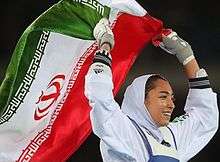
.svg.png)
.svg.png)









 Flag of the Azerbaijan People's Government
Flag of the Azerbaijan People's Government Flag of the Talysh-Mughan Autonomous Republic
Flag of the Talysh-Mughan Autonomous Republic

 Flag of the Republic of Mahabad
Flag of the Republic of Mahabad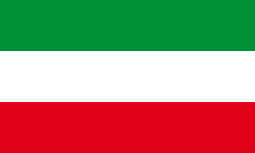
.svg.png)
 Flag of Mayen-Koblenz
Flag of Mayen-Koblenz

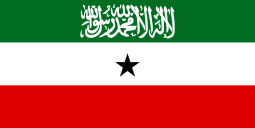
 Iran Constitution of 1906.
Iran Constitution of 1906.
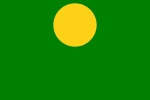


.svg.png)
.svg.png)








.svg.png)





.svg.png)
.svg.png)
.svg.png)
.svg.png)
.svg.png)
.svg.png)
.svg.png)
.svg.png)
.svg.png)
.svg.png)
.svg.png)